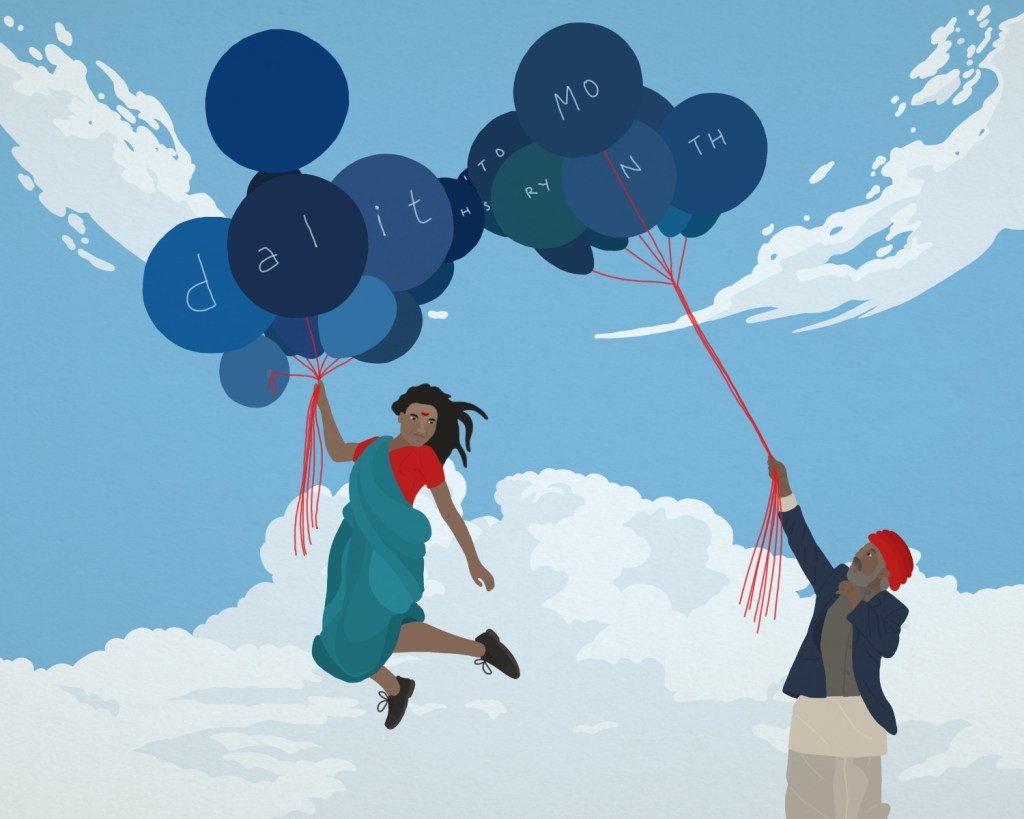Dalit History Month Is Not a Token


There are many definitions of history. But for me, as an artist, dreamer, and an unapologetic Ambedkarite, history has often been a crime scene — a place of distortion, manipulation, and theft. What they taught us in school was not our past. It was the propaganda of the powerful. It was mythology stitched together to keep us docile, grateful, and forgetful. I was made to memorize the names of those who enslaved us, sing anthems of unity that demeaned our diversity, and admire writers who never saw us.
The textbooks were not written for me. They were written against me.
The authors were not my people. They didn’t speak my language, share my pain, or reflect my reality. And when they did write about us, about the Dalits, the Adivasis, the Bahujans, they did it with a gaze. We were either invisible or exoticized. Either deviant or dehumanized. Never complex, never dignified, never in charge of our own narratives.
I was orphaned by history and then forced to worship the people who burned my house down. I was told our ancestors were “illiterate, savage, filthy.” But who built India’s temples and skyscrapers? Who cleaned its streets? Who carried the dead and bore the burden of the living? Who taught resistance without ever being taught? Who created Indigenous knowledge? Who carved the first stones and painted the first walls? Our histories of struggle, of survival, of brilliance were not lost. They were looted.

So we reclaimed the pen, the brush, the chisel, and the camera.
We began writing ourselves into existence in songs, in sculptures, in artworks, in oral traditions, and on the streets. Not to beg for space, but to seize it. Even make it. Not to decorate the margins, but to burn them. And in this fire, we found each other.
Dalit History Month, founded a decade ago by anti-caste activists including Thenmozhi Soundararajan and Christina Dhanuja and celebrated each April, is not a token. It is a tactical intervention. A crack in the Brahminical fabric of Indian memory. It’s not a request for inclusion; it’s a declaration of rupture. One month cannot compensate for centuries of epistemicide, the deliberate erasure of our knowledge, our voices, our ancestors. But it can become a spark. A beginning. A ritual of remembrance and resistance.

We do not celebrate for spectacle. We do not mourn for pity. We organize because our liberation is not negotiable.
Dalit History Month is a creative battle cry for dignity, for representation, for justice. It is not limited to Dr. B. R. “Babasaheb” Ambedkar, though he remains a guiding star and radical architect of liberty, equality, and fraternity. It is also a time to honor those who were rarely named in state archives but always remembered in our homes.
We remember Savitribai Phule, who was stoned for teaching girls but never stopped walking to school. We remember Ramabai Ambedkar, who lived through poverty and grief so her partner could write the Constitution of an independent India. We remember Jyotiba Phule, who opened schools for Dalit students in the mid-1800s when the state refused to educate us. And Shahuji Maharaj, the king who waged a war of policy against caste in the early 1900s by reserving jobs and education for the oppressed at a time when even talking about caste was dangerous.

We remember Fatima Sheikh, who taught side by side with Savitribai, even when her own community disowned her. Babytai Kamble, the writer who broke the silence of Dalit womanhood with her raw, unflinching words. We remember Jhalkari Bai, the brave Dalit woman soldier who entered battle disguised as Rani Laxmibai in 1858 and fought the British army. Uda Devi, who climbed a tree and shot down British officers during the 1857 rebellion, her body eventually riddled with bullets and her name omitted from textbooks.

We remember Birsa Munda, the young Adivasi leader who led the Ulgulan, the great rebellion, not just against the British but against dominant-caste landlords who exploited his people. His bones still echo in the forests of Jharkhand. We remember the poets Kabir and Ravidas, whose verses shattered the silence of caste and whispered equality into generations of dreamers.
And we also remember the present. Grace Banu, who hacked her way through both transphobia and caste discrimination to become a voice in tech and policy. Rohith Vemula, who took his own life in 2016, an institutional murder in a university space that reminded us that Brahminism doesn’t disappear with English education or a university seat, it mutates.

This month is also for the unnamed, the countless victims of manual scavenging, caste lynchings, sexual violence, and systemic neglect. It is for every broken back and burning pyre. For the sweepers who were told their hands were dirty but whose touch was always divine. It is a collective mourning and a collective sharpening of our expressive tools.
We do not only want history. We want revolution. And we are not waiting for permission. Because we’ve seen what happens when we wait — for justice that never came, for representation that always excluded, for savarnas to change, for institutions to reflect, for governments to care.

And all we got was silence, violence, and textbooks that called our pain “problems of the past.” So now, we no longer wait. We write. We sing. We draw. We speak. We design. We organise. We revolt.
Babasaheb did not teach us to beg. He taught us to think. Rethink. To agitate. To dismantle. To recreate. We are living in the age of redesigning Indian aesthetics. This will not be possible without the marginalized communities, or else we’ll be stuck with the same mediocre imagery in pop culture that has stereotyped and stopped the progress of artistic thought in India for a very long time. It is time for the real proletariat of the country to take charge of the stories that can really build this nation and put it back on the path of progress and justice. Babasaheb reminded us that caste is not just a social evil, it is a weapon. Systemic, brutal, and still socially legitimate. And unless we destroy its roots, we will always be treated as weeds.

Dalit History Month is not a festival. It’s a fire. Lit in memory, fueled by rage, carried forward in love.
It reminds us that our very act of remembering is resistance. Our names are monuments. Our stories are revolutions.
And through this fire, we will forge a future. Not of tolerance but of transformation. Not of inclusion of castes but of annihilation of caste. Not of borrowed narratives but of reclaimed power. Our aesthetics are political. Our memories are maps. Our dreams are blueprints for a better world.
This is not a month on a calendar. It’s a movement in our bones. It’s history. Not as it was written, but as we are writing it now. And this time, it will not be erased.




